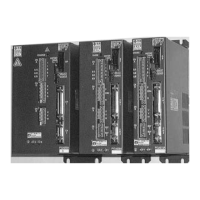9. SPECIFICATIONS
9-42
(5) General Specifications of CN1 Input/Output Signals
(ABS-E Absolute Encoder, ABS-RⅡ Absolute Sensor and ABS-E.S1 Wiring-saved Absolute Sensor)
This section explains the general specification of CN1 input/output signals of the velocity control type.
Table 9-9 General Specifications of Velocity Control Type Input Signal
(ABS-E Absolute Encoder, ABS-RⅡ Absolute Sensor and ABS-E.S1 Wiring-saved Absolute Sensor) 1/2
Signal name Abbr.
Pin No.
*1
Circuit type
*2
General specification
Speed command VCMD 21 (20) Type 3
With a ±2 V input, the velocity becomes 1000 min
-
1
in
the standard setting (maximum input voltage ±10 V).
Torque
compen-
sation Torque
command
TCOMP
TCMD
22 (20) Type 3 With a ±2 V input, the velocity becomes the rated one
(TR). It is limited to the instantaneous maximum stall
torque.
Servo ON SON 37 (23) Type 1 Servo ON status is provided by closing the contact and
entering the velocity command input (VCMD) waiting
status.
Alarm reset RST 30 (23) Type 1 With this signal input, alarm code or alarm bit outputs
and an error display are reset.
Forward revolution
current limit
PIL 18 (17) Type 4 The current is limited to the rated
current at +2 V (effective when ILM
is input).
Backward revolution
side current limit
NIL 19 (17) Type 5 The current is limited to the rated
current with -2 V (effective when
ILM is input).
To enable the
external current
limit, Func1 bit0
must be set at "1".
Current limit permit ILM 31 (23) Type 1 The current is limited by closing the contact.
It is ineffective during JOG or overtravel (the limit
method is based on the Func1 parameter).
Forward revolution
overtravel
Backward revolution
overtravel
PROT
NORT
32 (23)
33 (23)
Type 1 Contact open status is provided upon occurrence of
overtravel. Input both the forward and backward
revolution signals. When overtravel occurs, a 120%
current limit is automatically applied, making the speed
of the side to which this signal has been input zero.
(This function can be canceled or changed into an
a-contact input by setting the remote operator.)
Encoder clear
(standard)
ECLR 35 (50)
36 (23)
Type 1
Inputting this signal for over 4 seconds will clear the
encoder revolution counter (multiple revolution). When
a battery alarm ("U") occurs, input this alarm and reset
the alarm.
External overheating
detection
EOH Normal operation while input is on.
The external overheating alarm state is assumed when
input is turned off.
Proportional control
(standard)
PCON When the motor drifts during a long stop time due to
command input zero, inputting this signal stops the
motor by friction torque. (Function disabled for torque
control type)
Zero clamp ZCMD Inputting this signal makes the speed command 0
(zero). (Function disabled for torque control type)
Internally set velocity
select
VCS2 /
VCS1
Combining CN1 - 35 and 36 input signals enables a
desired internally set velocity to be selected. (Function
disabled for torque control type)
Battery power BAT+
BAT−
1
2
Type 10 This signal connects a 3.6 VDC equivalent battery
(ER6 2000 mAH from Toshiba Battery is recommended).
Input sequence power
supply 1
23
External power supply for CN1 - 30, 31, 32, 33, 36 and
37.
Input sequence power
supply 2
5 to
24 VDC
50
―
External power supply for CN1 - 35.
Internal velocity
command revolution
direction
ROTS 34 (50) Type 1 This signal specifies the revolution direction when the
internal velocity command is turned on.
*1 The pin numbers in parentheses denote the ground or common side of each signal.
*2 For the circuit type, see Fig. 9-20.
For 35 and
36 pins, one
of the five
functions
can be
selected by
setting the
remote
operator.

